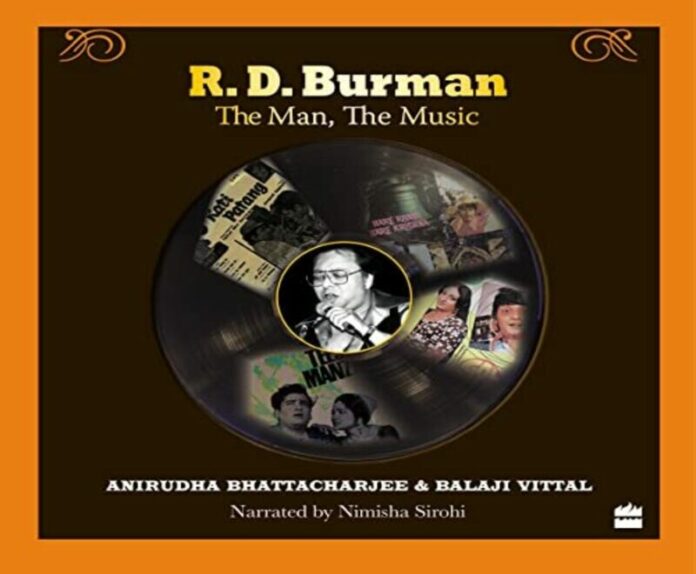Over a decade and a half has passed since the charismatic music director R.D. Burman ascended to his heavenly abode. However, his legacy lives on forever, as Burman also known as Panchamda, was way ahead of his time and knew the pulse of the masses. The musical genius is known for record-breaking Bollywood tracks like Jab Hum Jawan Honge, Kya Hua Tera Wada, Mehbooba Mehbooba, and Bachke Rehna Re Baba. The memoir R.D. Burman: The Man, The Music on Audible delves into his early life, illustrious career, and phenomenal contributions to music. Here are some lesser-known facts about the fascinating music director and his repertoire from this Audible audiobook.
How R.D. Burman Got the ‘Panchamda’ Title
R.D. Burman was born to a well-known music director Sachin Dev Burman in Kolkata, he learned songwriting and composing music from his father. Panchamda/Pancham wrote his first song when he was nine years old.
“A few months before the Second World War broke out, Rahul was born to Meera and Sachin Dev Burman at 9:29 am on 27th June 1939 at Hindustan Road near Garia Hat, South Calcutta. He was nicknamed Tublu, the nickname Pancham came some years later. Apparently as a child, he wailed at the fifth note of the Sapta Swara.”
The Reason Behind His Lucky Number ‘5’
Though his first independent musical composition was in the year 1961 for the film ‘Chhote Nawab’. R.D. Burman’s first successful hit was Teesri Manzil in 1966.
“There is another story, Rahul would invariably sing the note Pa whenever his father sang the note Sa. Thespian Ashok Kumar thus gave him the name Pancham as per multiple interviews with Pancham. Incidentally, the number 5 proved lucky for him in his early career. Teesri Manzil, 1966 his first major hit was Pancham’s fifth film as a composer.”
Panchamda often used foot tapping and natural sounds in his music composition
R.D. Burman was known for his flair for experimental music and utilized natural sounds of rain and household objects in his recording process. In the music for the film ‘Chote Nawab’, Pachamda incorporated the musical instrument Reso Reso and foot-tapping noises in his composition.
“A duet between Lata Mangeshkar and Mohammad Rafi, where the rhythm was maintained on a second repercussion instrument – The Reso Reso. The song was from the film ‘Chote Nawab’ which was released a few months back, the composer was a debutant – Rahul Dev Burman who according to Kersi Lord contributed to the song with his foot tapping and clapping too. The first line of Matwali Ankhon Wale was in a way written by Rahul himself.”
Incorporating Latino Music in Bollywood Tracks
The Legendary composer brought the best of the worlds together in his music, an ardent admirer of Latino Music as a result of his upbringing in Calcutta. Panchamda used it to create a unique masterpiece – Maar Dalega Darde Jigar’ for the movie Pati Patni in 1966.
“Exposed to Latino music in Calcutta, Pancham over the years had developed a fondness for its vibrancy. He soon made the Bosanova form his very own, literally bringing it halfway across the globe, from the beaches of Rio to the studios of Bombay. Where he dovetailed it with a pentatonic tune to create a song for Pati Patni in 1966. Sung by Asha Bhonsle and picturized on Shashikala playing a seductress. ‘Maar Dalega Darde Jigar’ was not a colossal hit, not even a modest one during that time. But has since become an icon, for its novel structure unlike a majority of songs in popular Hindi music around that time”.
‘Mehbooba Mehbooba’ was Panchamda’s first time as a singer
The evergreen Bollywood hit ‘Mehbooba Mehbooba’ starring Helen was Panchamda’s first-ever musical stint as a singer. The song stood out among all the other tracks in one of the most famous Bollywood movies ever made.
“47 years after it was released Sholay remains the most enigmatic action musical ever made in India, the media response to the music of Sholay was not flattering, to begin with during its time Sholay was criticized as a film devoid of good songs except ‘Mehbooba Mehbooba’ which gave R.D.Burman a new identity – that of a lead singer.”
The Hit Dum Maro Dum was originally intended to be a duet featuring Lata Mangeshkar and Usha Uthup
Dum Maro Dum is the retro Bollywood hippie anthem of 1970, picturing the timeless beauty of Zeenat Aman the song encapsulates the shift towards hippie culture during that era. Pachmanda very brilliantly balanced the contrasting voices of Lata Mangeshkar and Usha Uthup to do justice to the iconic party song.
“How would ‘Dum maro dum have sounded with Lata Mangeshkar’s trifle shrill voice and Usha Uthup’s canyon-like contrast? Post the decision to turn it into an Asha solo, Pancham probably had to color the song differently as the voices of Lata and Asha are very different. An Asha Bhonsle tracks like ‘Dum maro dum had to have a blend of sultriness and wildness. Recorded in a number of versions and used in bits and pieces in the film, the song became the anthem of the hippie generation with its psychedelic view of life and anti-establishment convictions.”
R.D. Burman’s revolutionary music is celebrated even today and has left a profound impact on the Indian Music Industry. The man’s music remains timeless and inspires budding musicians and singers even today.

